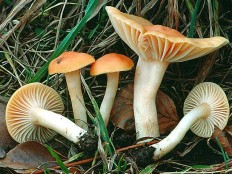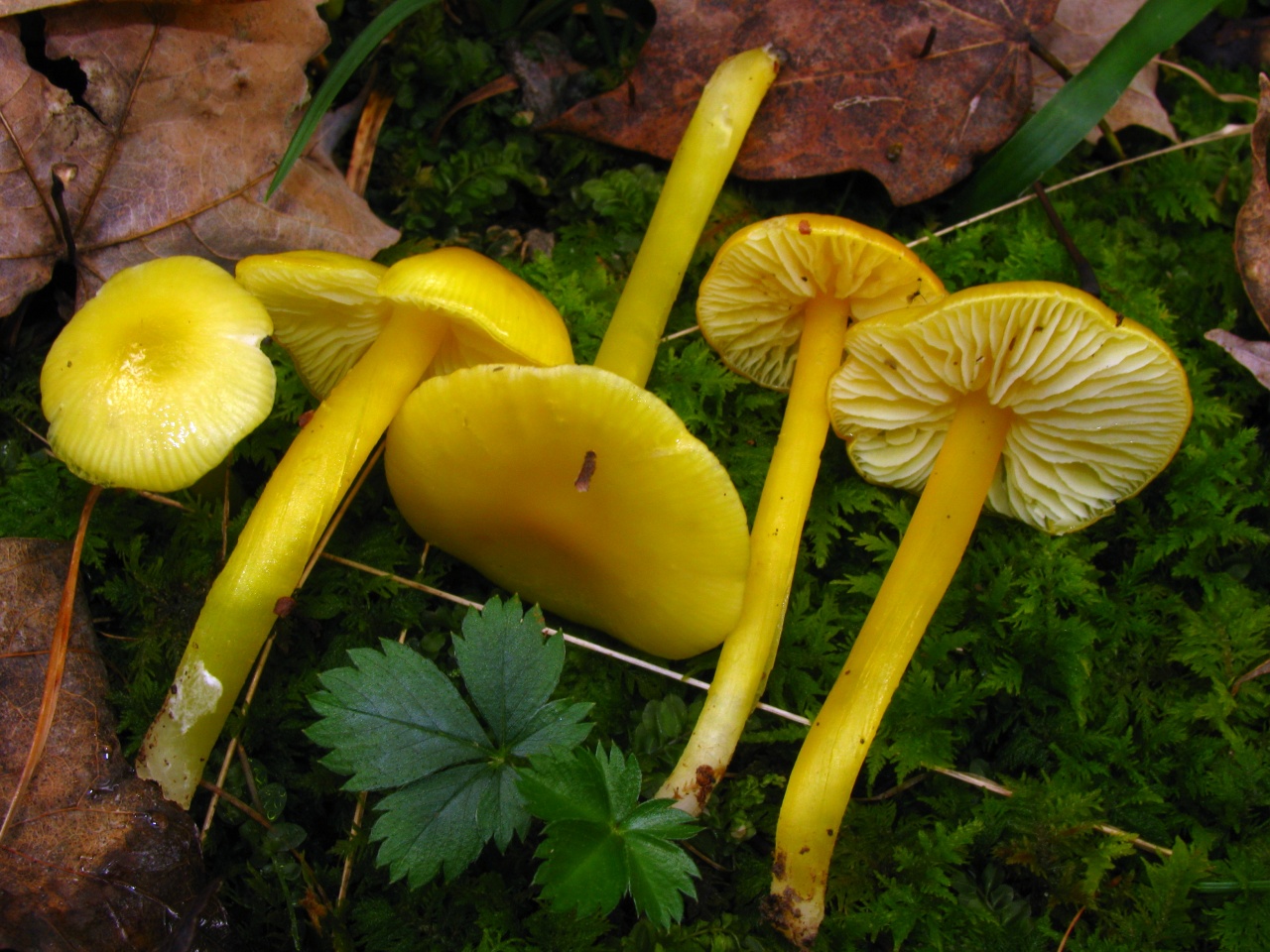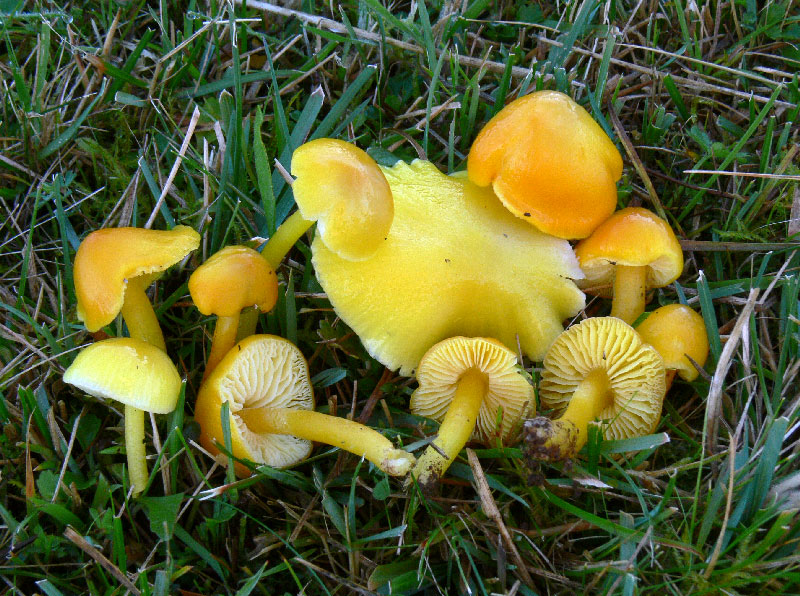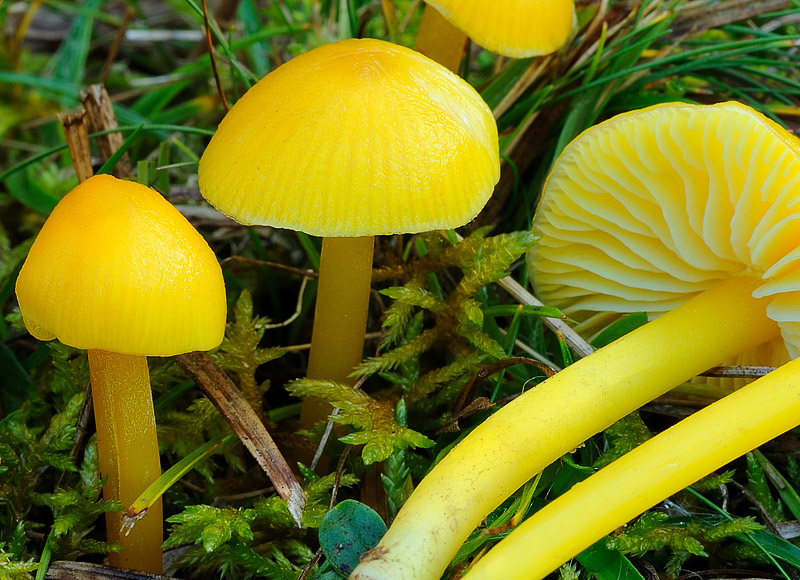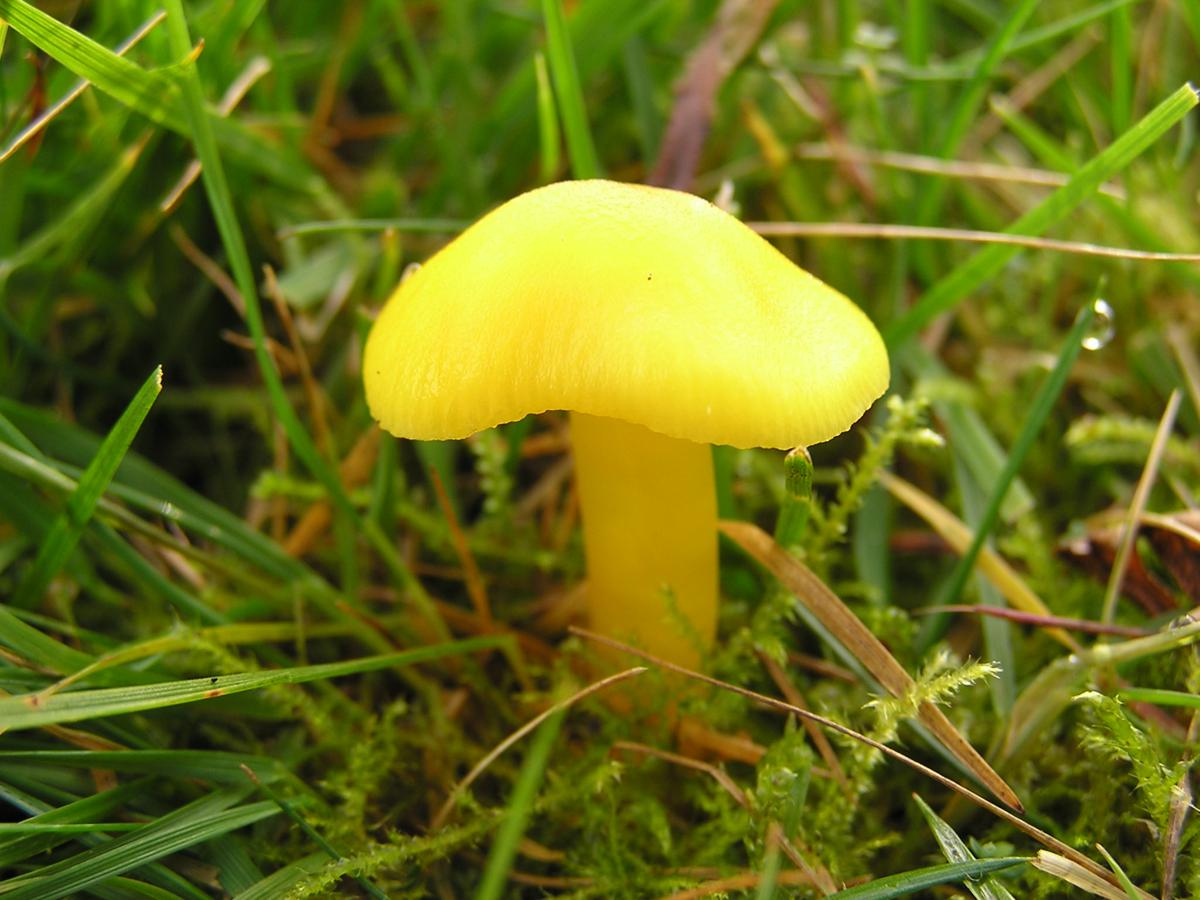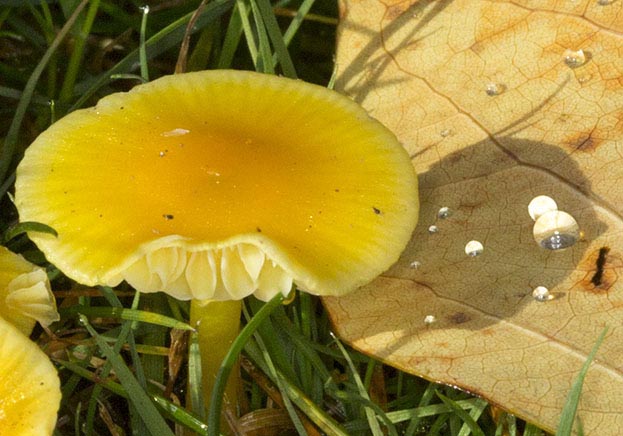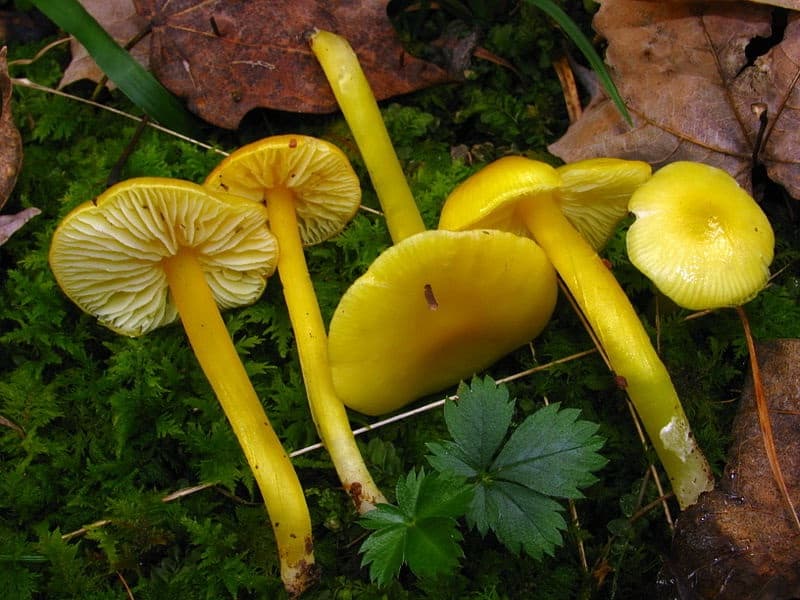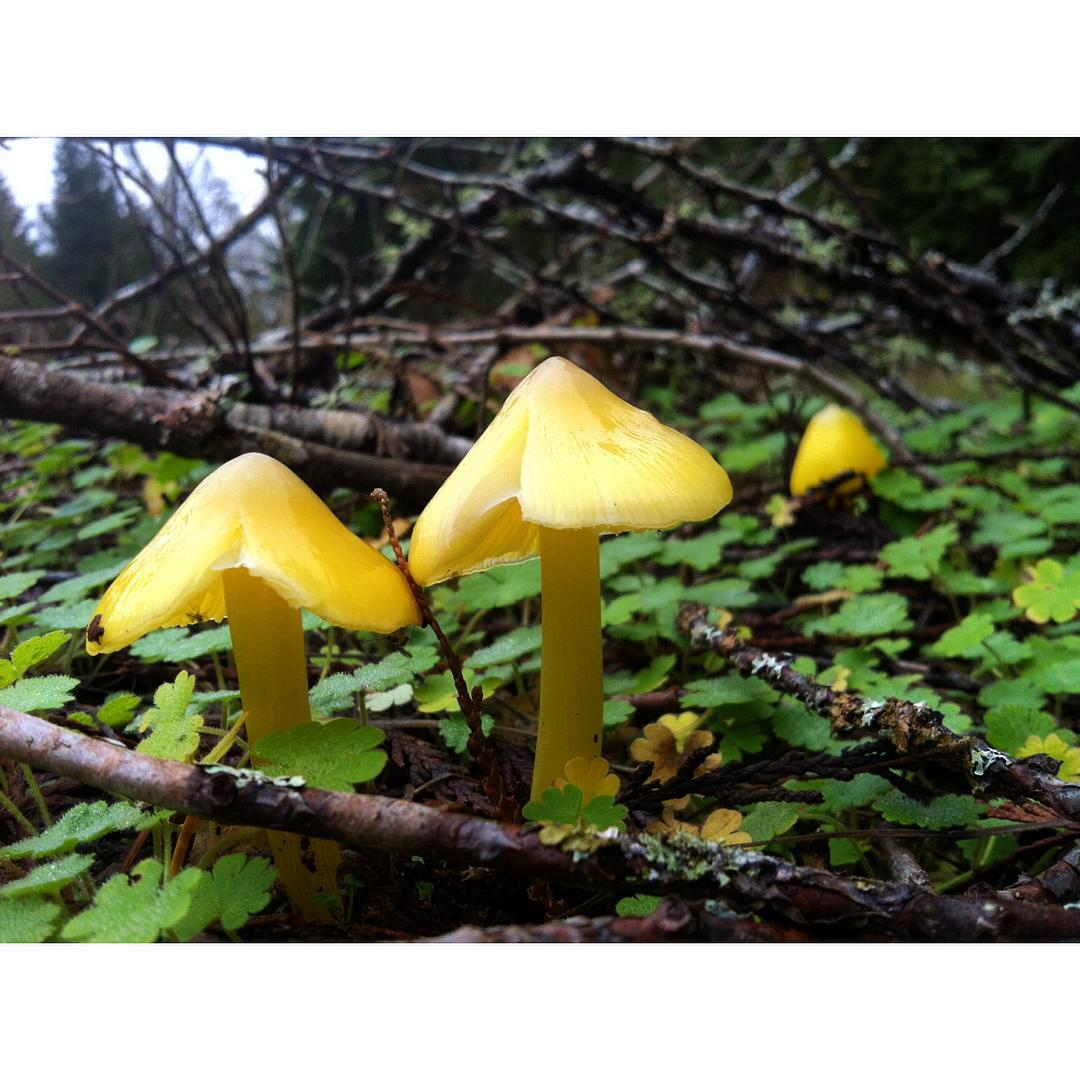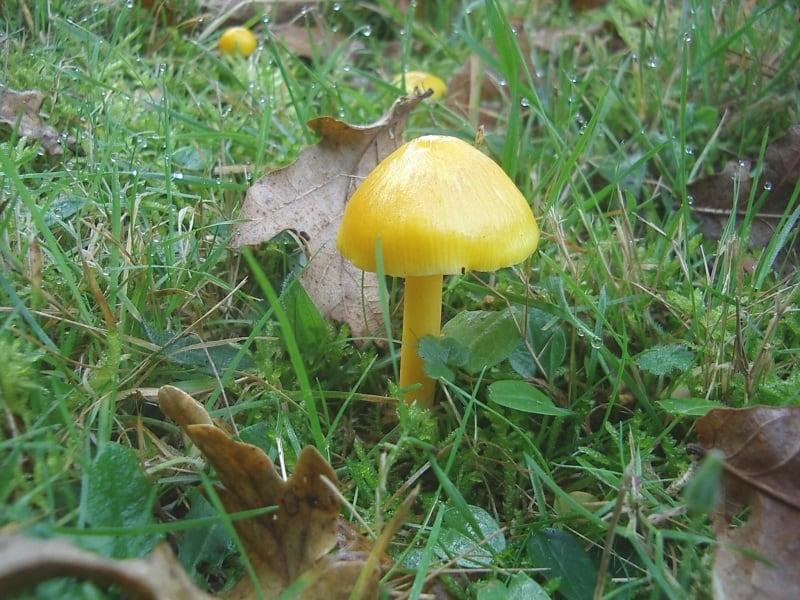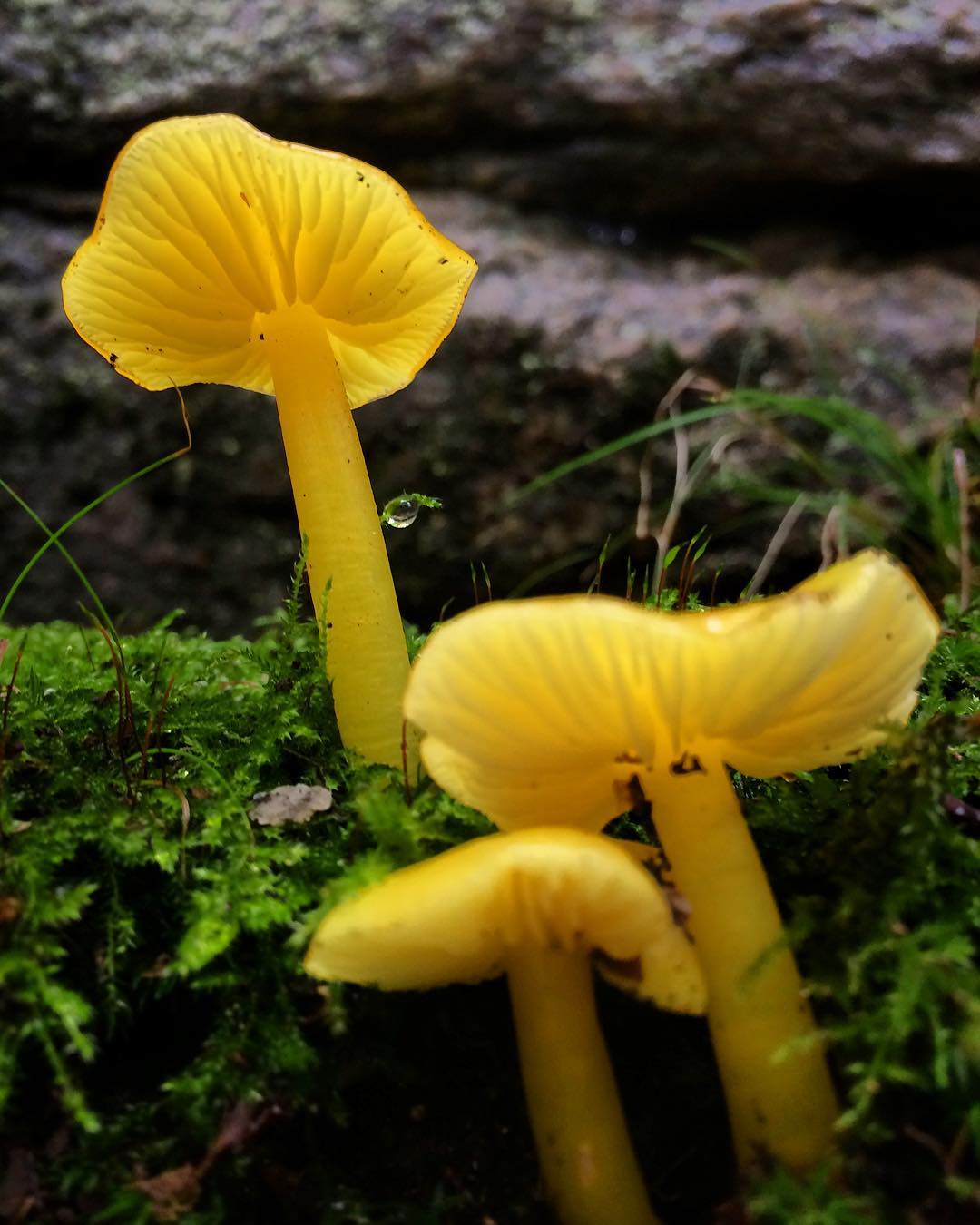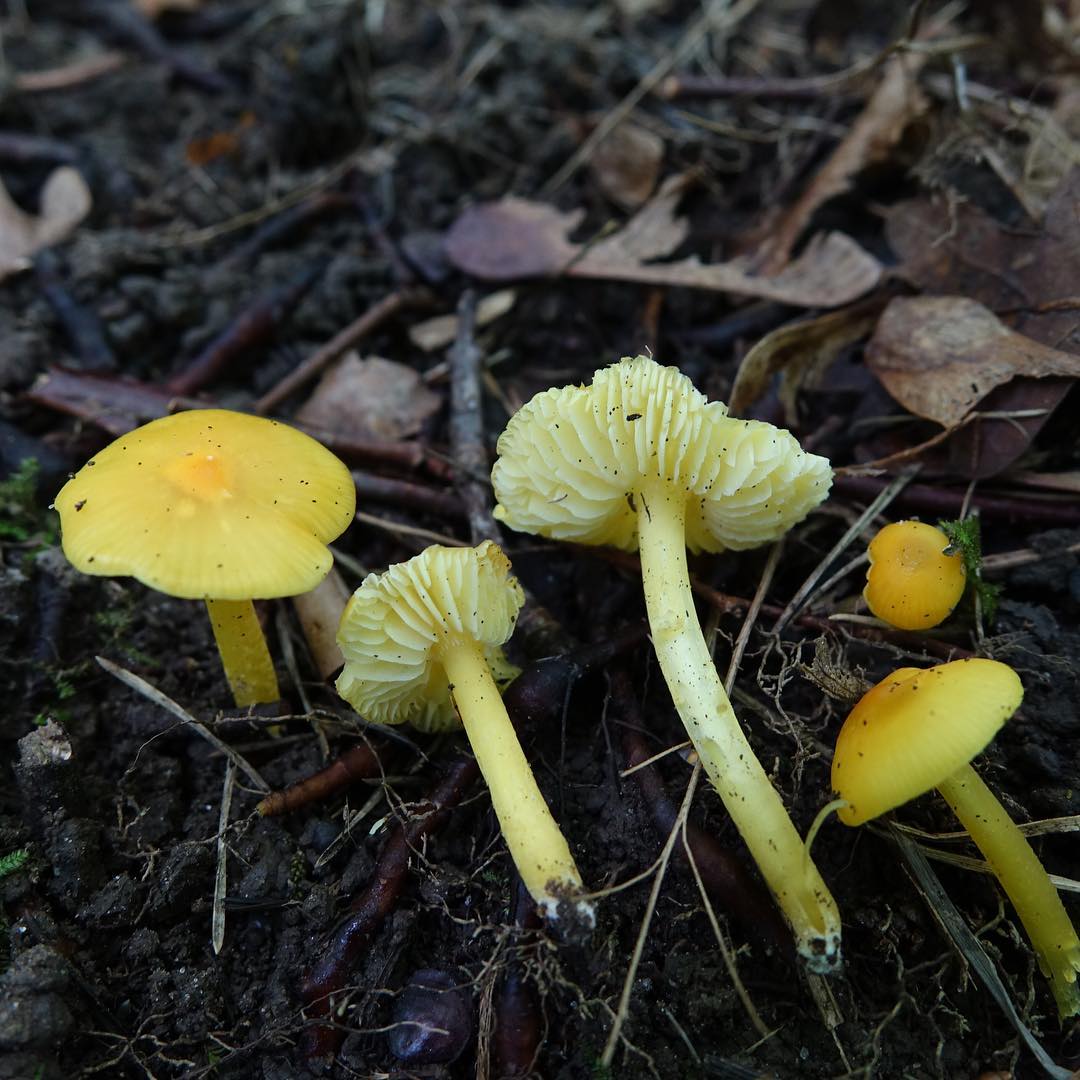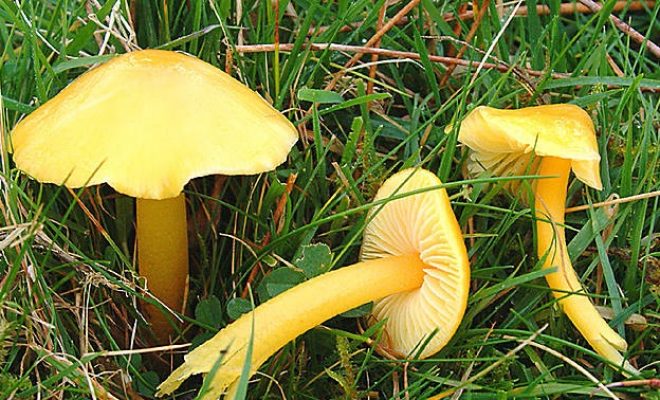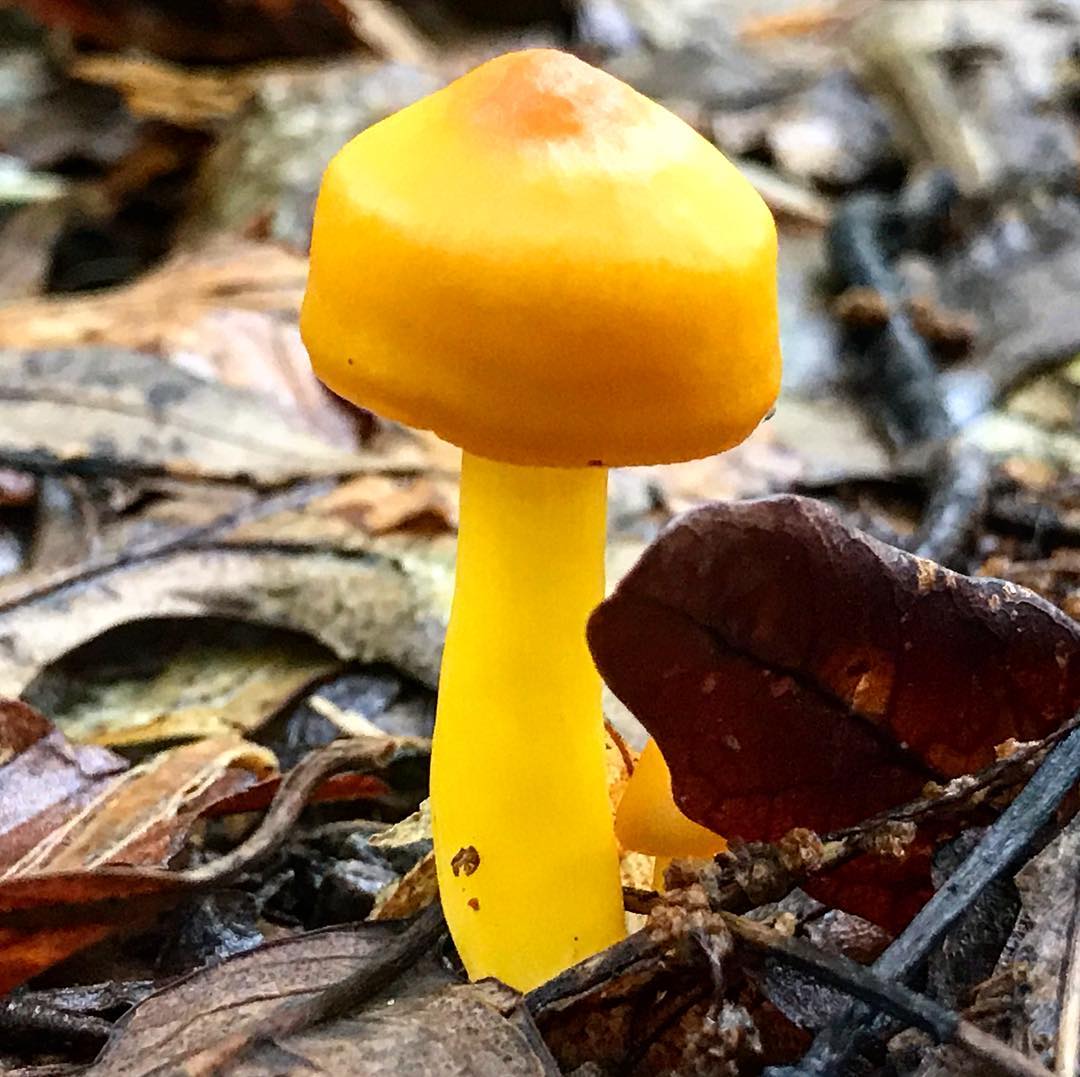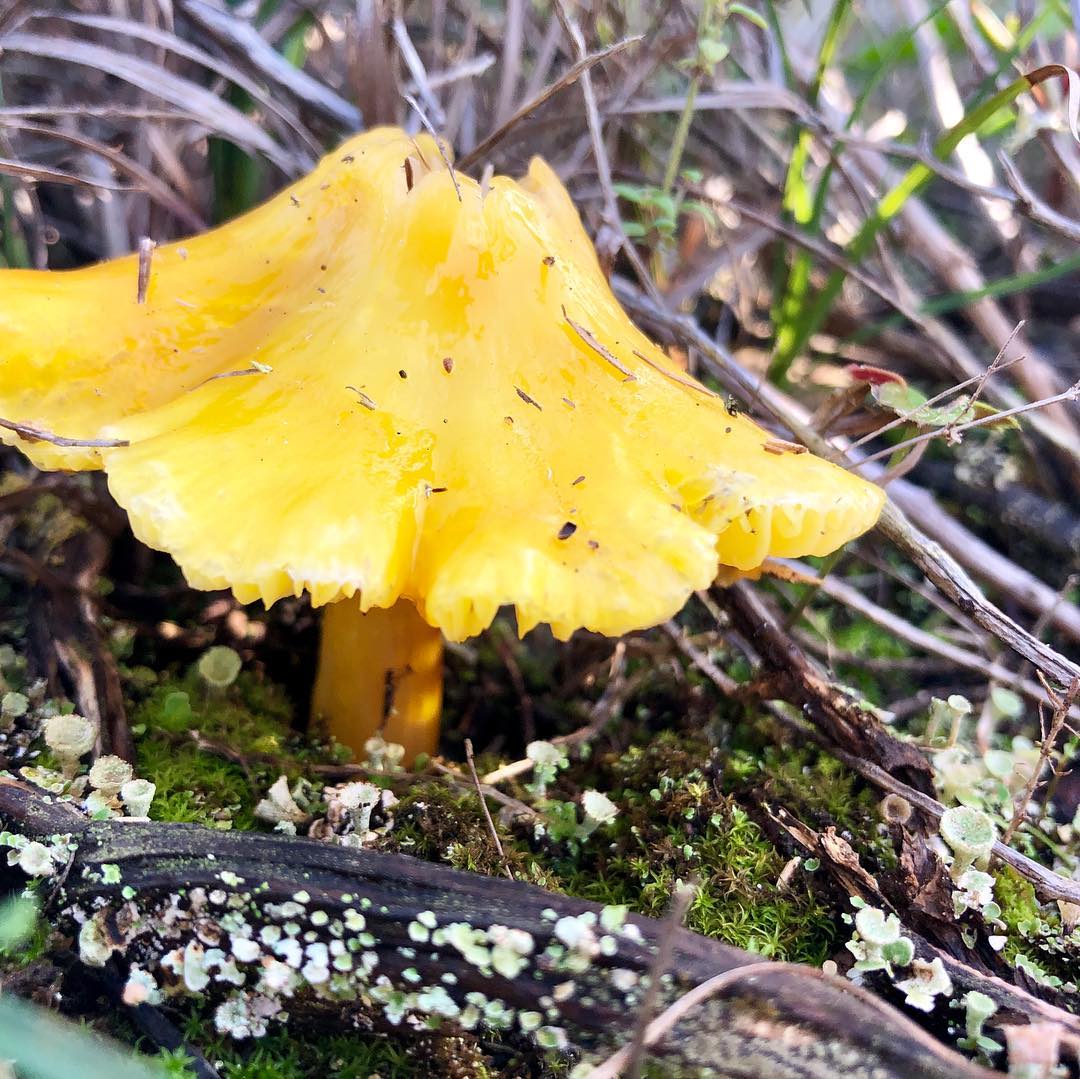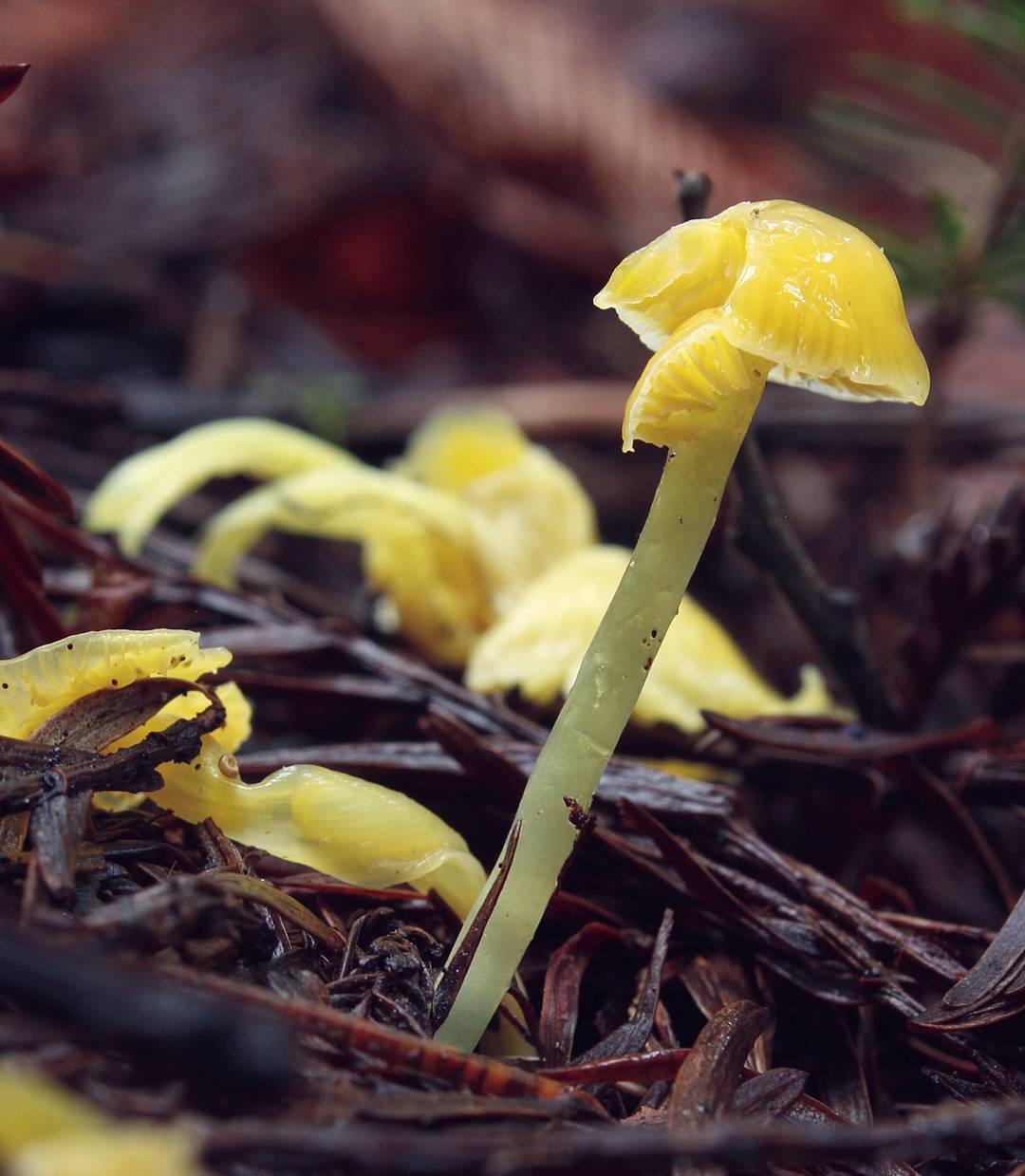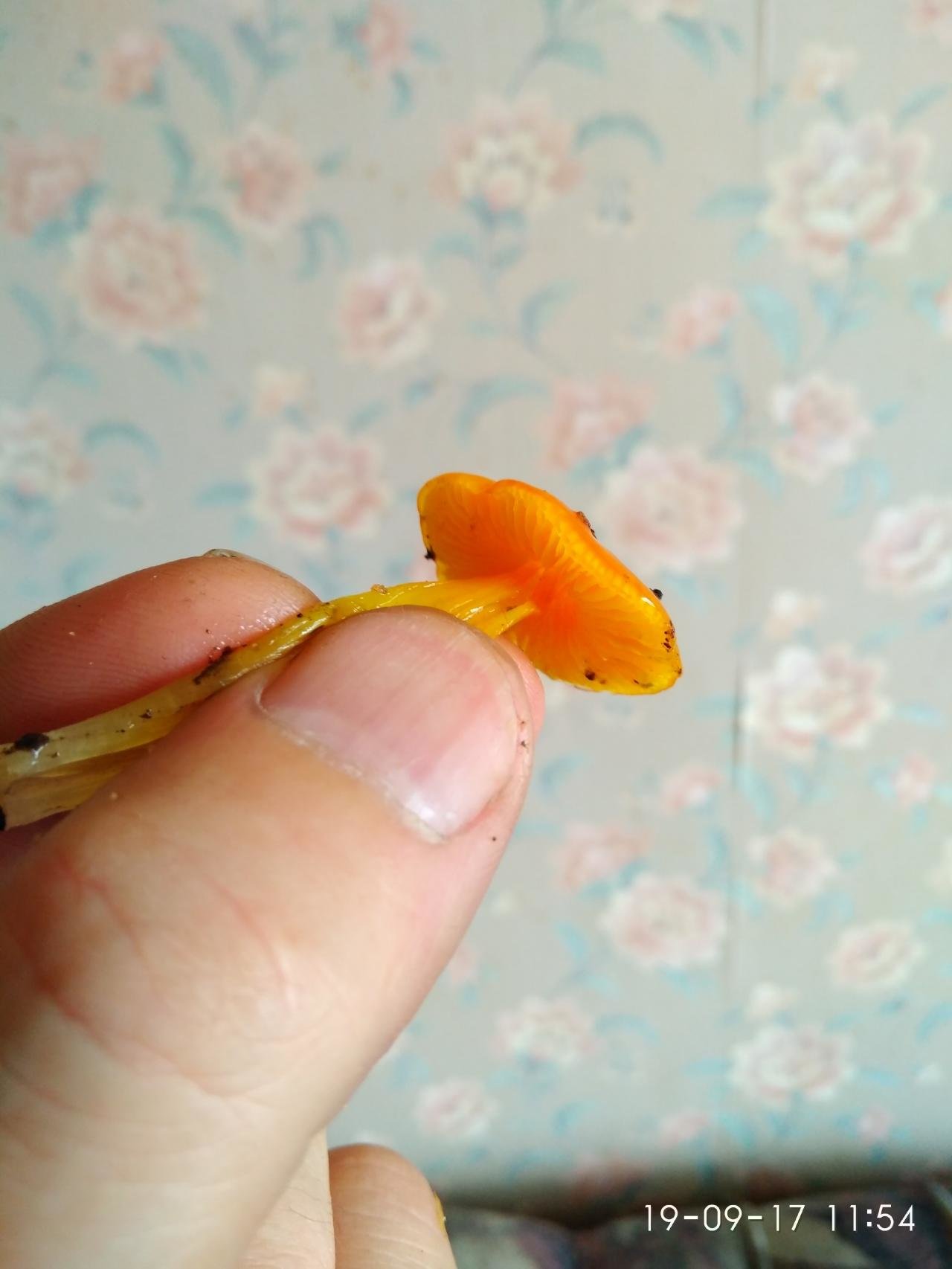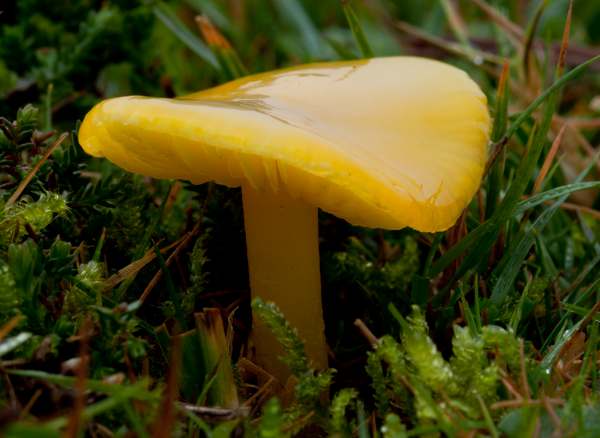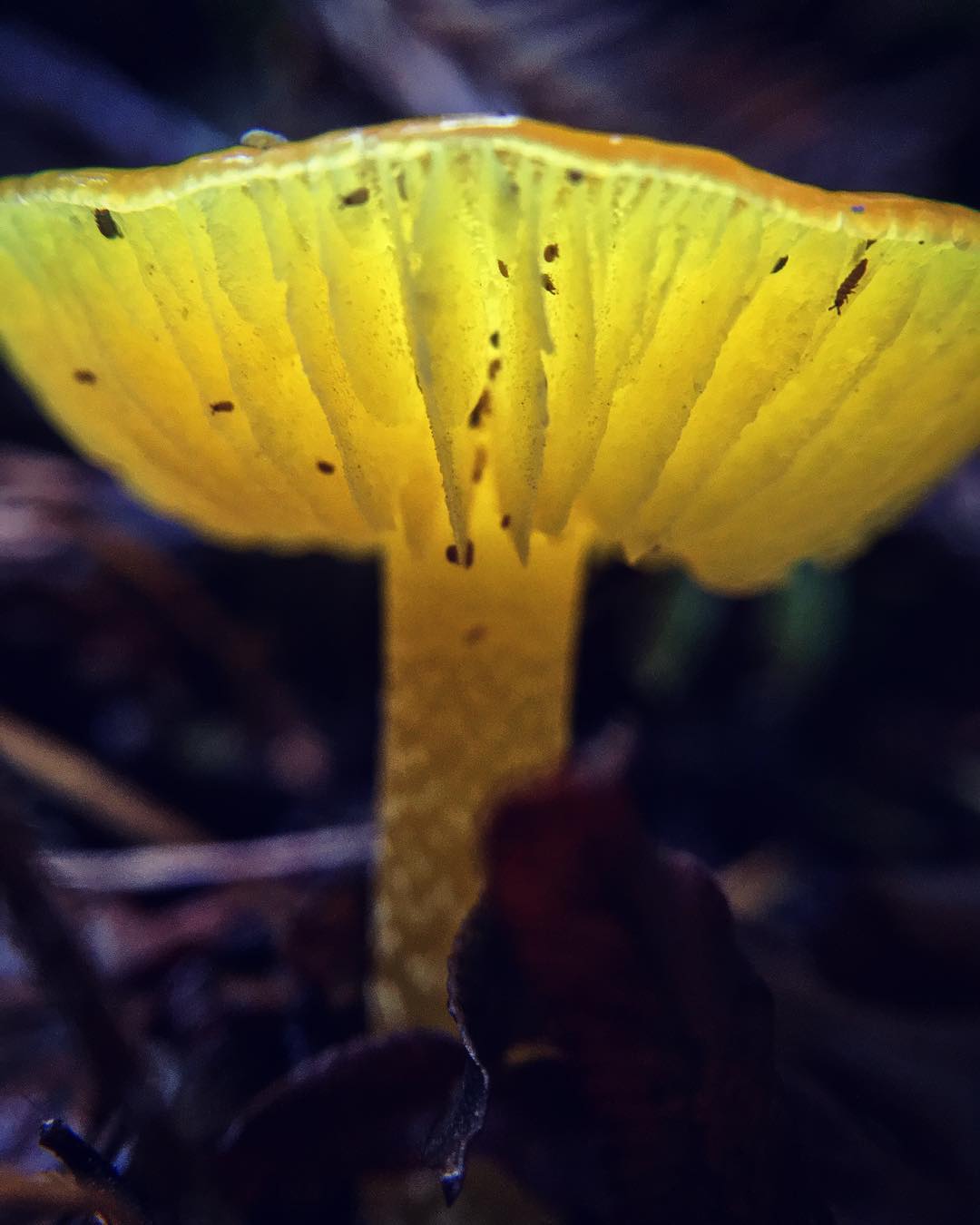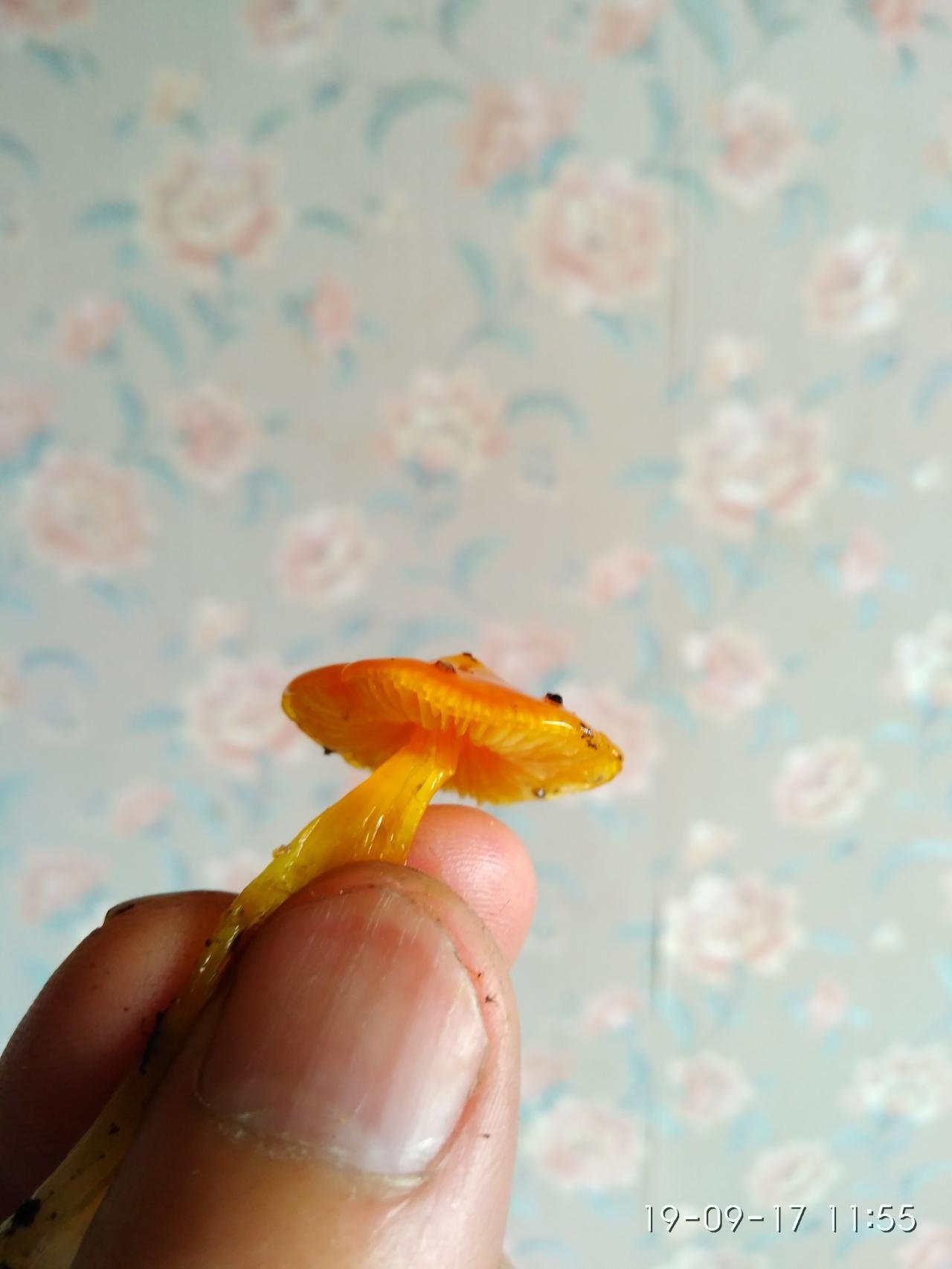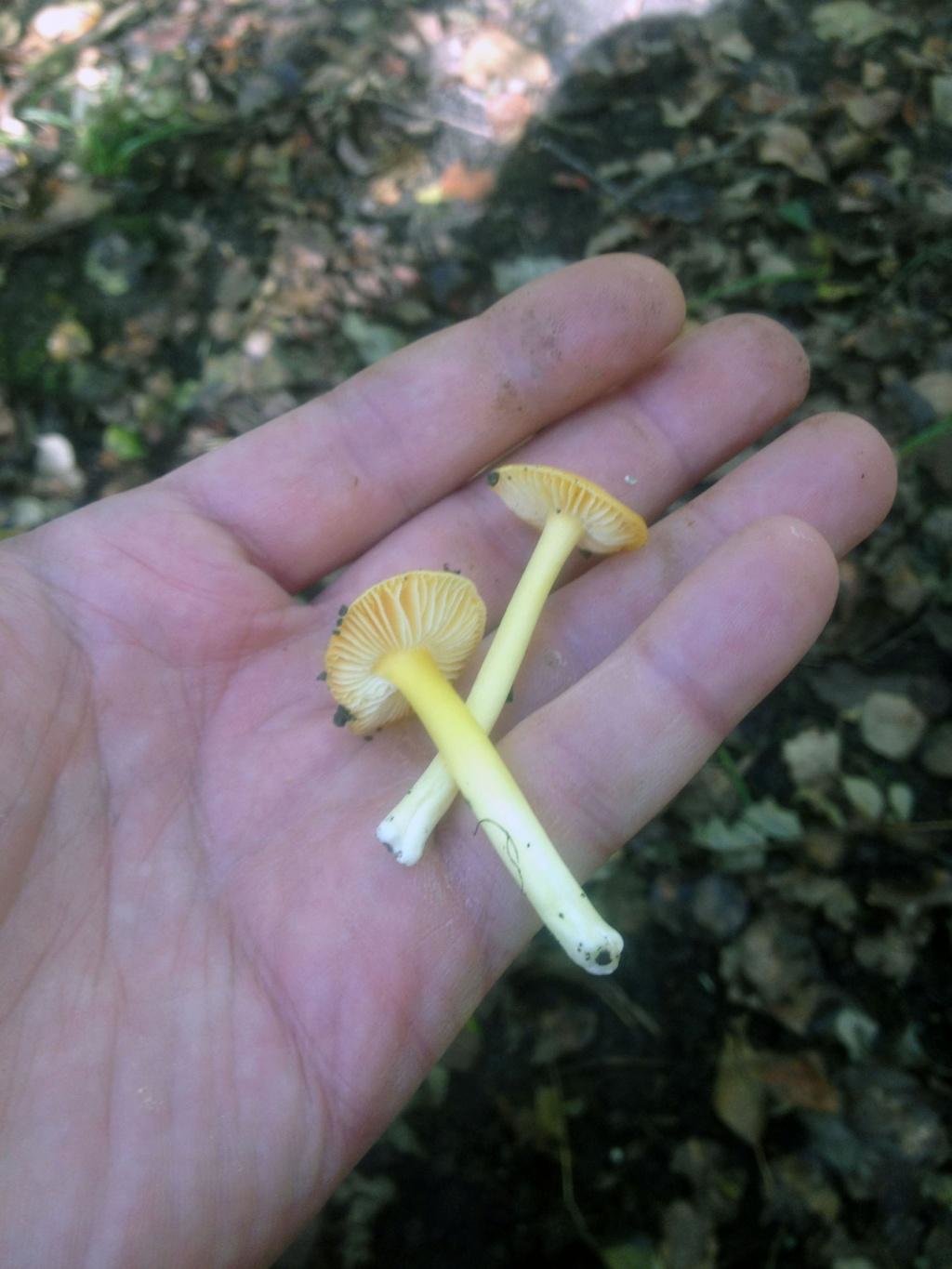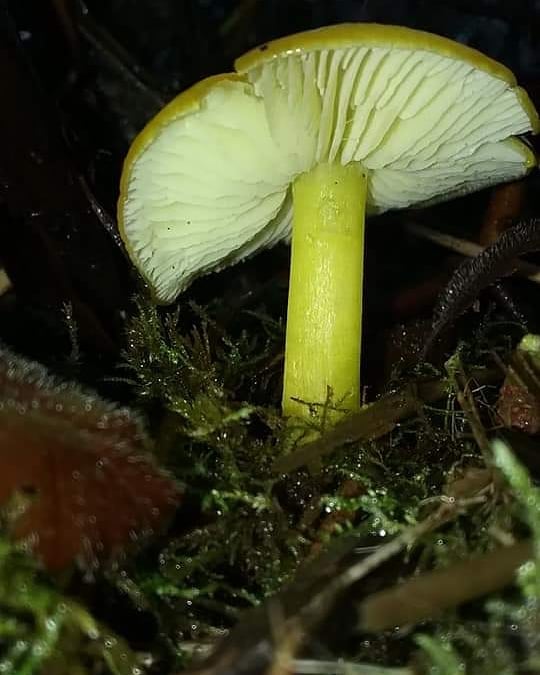Evaluation of edibility of a yellow-green hygrocybe
This mushroom is most often an inedible species. But in principle it can be eaten, however, its taste is too low.
Kindred hygrocybe yellow-green
Crimson hygrocybe is an edible mushroom. This is a bright and beautiful member of the family with a red or crimson hat. The shape of the cap at a young age is similar to a bell, and then it becomes flat. Its surface is covered with a sticky layer. Its diameter can reach 12 centimeters. The leg is thick, hollow inside, with grooves along its entire length. The pulp is firm with a pleasant aroma.

The fruiting period of the crimson hygrocybe falls on summer-autumn. You can find these mushrooms everywhere, in open places and in moist soils. Crimson hygrocybe has good taste.
The conical hygrocybe is an inedible member of the family. At a young age, the cap is acutely conical, by old age it becomes wide-conical, its diameter reaches 7 centimeters. The surface is fibrous, covered with a layer of mucus. The color of the cap is yellow or yellow-orange. The leg is hollow, also slimy, up to 12 centimeters high.
The conical hygrocybe bears fruit from summer to autumn. These mushrooms are found in meadows, pastures and in various forests. Poisonous substances are part of the hygrocybe acutely conical.

Hunting and fishing in the Tver region

Hygrocybe scarlet, Hygrocybe coccinea

Hat: More or less bell-shaped (in old shrunken specimens, however, it can be extended, and even with a notch instead of a tubercle), 2-5 cm in diameter. The color is quite variable, from deep scarlet to pale orange, depending on growing conditions, weather and age. The surface is small-bumpy, but the flesh is rather thin, orange-yellow, without a distinct smell and taste.
Plates: Sparse, thick, adherent, branched, cap color.
Spore powder: White.
Leg: 4-8 cm in height, 0.5-1 cm in thickness, fibrous, solid or made, often “flattened” from the sides, in the upper part of the cap color, in the lower part - lighter, up to yellow.
Distribution: Occurs in all kinds of meadows from late summer to late autumn, apparently preferring infertile soils, where hygrophoric soils traditionally do not meet serious competition.
Similar species: There are many red hygrocybes, and they can be distinguished with full confidence only through microscopic examination. However, most of the similar mushrooms are rare; Of the more or less common, popular authors point to the crimson hygrocybe, Hygrocybe punicea, which is much larger and more massive than the scarlet hygrocybe.
Edible: Scarlet hygrocybe is at least not poisonous, although as an edible mushroom it is not popular even among connoisseurs.
Author's Notes: Just one of the hygrocybes. If not for the color red, who would have remembered about it? However, we have seen both redder and more interesting - for example, the parrot hygrocybe radically changes color twice during the life cycle, and the crimson hygrocybe is very large. However, these mushrooms appear before a person, and even then not before everyone, once every seven years, but scarlet is always in sight. What, probably, is good. She must, in fact, be something good. Mushroom after all.
phrases
Wikipedia
Hygrocybe
From Wikipedia, the free encyclopedia
Go to:.
| ? Hygrocybe | ||||||||||||||
|---|---|---|---|---|---|---|---|---|---|---|---|---|---|---|
| Hygrocybe conica | ||||||||||||||
| Scientific classification | ||||||||||||||
|
||||||||||||||
| Latin name | ||||||||||||||
| Hygrocybe (Fr.) P. Kumm. 1871 |
Hygrocybe (lat.Hygrocybe) Is a genus of lamellar mushrooms of the Gigroforov family (lat.Hygrophoraceae).
Description
- Hat ∅ 0.5-12 cm, conical, bell-shaped or hemispherical, then prostrate, sometimes with a tubercle or depressed in the center, smooth or scaly, fibrous, dry, moist or slimy, usually brightly colored, red, orange-yellow, sometimes darkening or blackening with age.
- adherent or descending, thick, sparse, from white to brightly colored - red, pink, yellow.
- Leg cylindrical, often tapering to the base, dry or sticky, smooth or fibrous, often twisted, one color with a cap, hollow.
- Spore powder white.
Views
The genus has about 140 species with varieties, some of which are poisonous. There are about 130 species in Russia.
| Cat. * | Latin name | Russian name | ||||||||||
|---|---|---|---|---|---|---|---|---|---|---|---|---|
| Hygrocybe calciphila | Calcium-loving hygrocybe | |||||||||||
| Hygrocybe calyptaeformis(H. calyptriformis) | Hygrocybe cap-shaped | |||||||||||
| Hygrocybe cantharellus | Chanterelle hygrocybe | |||||||||||
| Hygrocybe ceracea | Hygrocybe wax | |||||||||||
| Hygrocybe chlorophana | Hygrocybe yellow-green, hygrocybe dark green | |||||||||||
| Hygrocybe citrinovirens | Hygrocybe lemon green | |||||||||||
| Hygrocybe coccinea | Hygrocybe red, hygrocybe scarlet | |||||||||||
| Hygrocybe conica | Conical hygrocybe | |||||||||||
| Hygrocybe flavescens | Hygrocybe yellowing | |||||||||||
| Hygrocybe flavipes | Hygrocybe gray | |||||||||||
| Hygrocybe intermedia | Hygrocybe intermediate | |||||||||||
| Hygrocybe irrigata | Hygrocybe watery | |||||||||||
| Hygrocybe laeta | The hygrocybe is beautiful, the hygrocybe is bright | |||||||||||
| Hygrocybe marchii | Hygrocybe March | |||||||||||
| Hygrocybe miniata | Hygrocybe cinnabar red | |||||||||||
| Hygrocybe mucronella | Spicy hygrocybe | |||||||||||
| Hygrocybe nigrescens | Blackening hygrocybe | |||||||||||
| Hygrocybe ovina | Sheep hygrocybe | |||||||||||
| Hygrocybe persistens | Hygrocybe acute conical | |||||||||||
| Hygrocybe pratensis | Meadow hygrocybe | |||||||||||
| Hygrocybe psittacina | Parrot hygrocybe, pistachio hygrocybe, motley hygrocybe | |||||||||||
| Hygrocybe punicea | Hygrocybe crimson | |||||||||||
| Hygrocybe quieta | Hygrocybe oak | |||||||||||
| Hygrocybe reidii | Hygrocybe Redi | |||||||||||
| Hygrocybe russocoriacea | Red-skinned hygrocybe, yuft hygrocybe | |||||||||||
| Hygrocybe spadicea | Hygrocybe brown-red | |||||||||||
| Hygrocybe splendidissima | The hygrocybe is brilliant, the hygrocybe is the finest | |||||||||||
| Hygrocybe strangulata | Hygrocybe suffocating | |||||||||||
| Hygrocybe turunda | Hygrocybe lint | |||||||||||
| Hygrocybe unguinosa | Hygrocybe smeared | |||||||||||
| Hygrocybe virginea | Snow-white hygrocybe, maiden hygrocybe | |||||||||||
| Hygrocybe vitellina | Hygrocybe egg yellow | |||||||||||
|
Literature
- P. Jansen, All about mushrooms. - SPb .: Publishing House "Kristall", 2006
- P. Harding, Mushrooms. Mini-encyclopedia. - M .: AST, 2002
- Funghi - Instituto Geografico De Agostini, Novara, Italia, 1997
- Garibova L.V., Sidorova I.I. Mushrooms. Encyclopedia of the Nature of Russia. - M .: 1999
- F.V. Fedorov, Mushrooms. - M .: Rosagropromizdat, 2002
Advertizing ▼
Hygrocybe yellow-green (Hygrocybe dark chlorine)

Hygrocybe dark chlorine
This mushroom belongs to the hygrophoric family. It is very small, somewhat reminiscent of a magical fairy mushroom, largely due to its acid color, thanks to which it seems that the mushroom is illuminated from the inside. The mushroom can be used for food, but its taste is very low.
The diameter of the cap can vary. There are very small mushrooms with a cap up to 2 cm in a circle, and there are also those in which the cap can reach 7 cm.At the beginning of its growth period, the yellow-green hygrocybe looks like a hemisphere, and during growth it acquires a more convex shape. Then, on the contrary, it changes almost to flat.
Sometimes you can find mushrooms in which there is a small tubercle inside the cap, and in other cases, on the contrary, there may be a small depression in the center. The hat usually has a very bright, catchy color, mostly orange-yellow or lemon-yellow. On the surface, the mushroom is covered with a sticky base, the edges are usually slightly ribbed. The cap has the property of increasing in volume (hygrophane) due to the fact that a certain amount of liquid is retained inside the pulp.
If you press lightly on the pulp, then it can break immediately, because it has a very fragile structure. The pulp is usually also yellow in a wide variety of shades (from bright to light). The yellow-green hygrocybe does not have a special taste, there is practically no smell, only a mushroom aroma is slightly felt. The plates of the fungus adhere to the stem, during ripening they are white, and as they grow, they turn yellow or may become brighter (for example, yellow-orange).
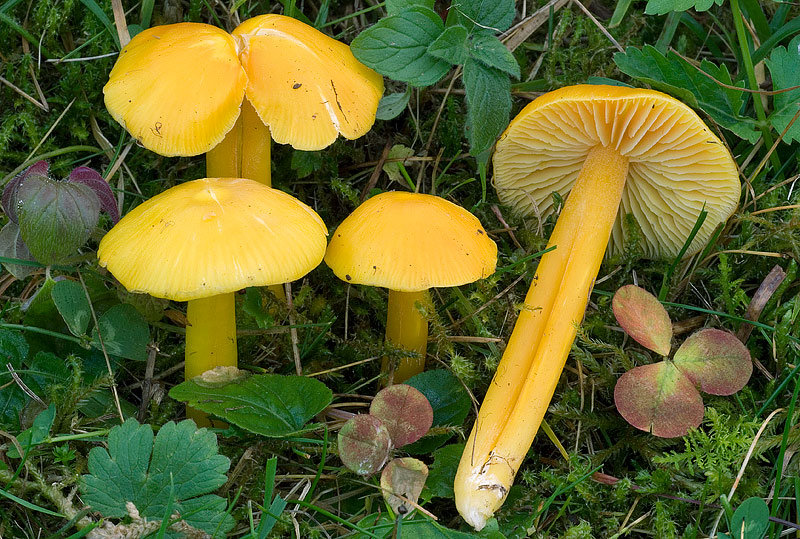
Hygrocybe dark chlorine sometimes has a very short leg (about 3 cm), and sometimes quite long (about 8 cm). The leg is rarely more than 1 cm thick, so it is very fragile.On the outside, it is usually wet and sticky, although the inside becomes hollow and dry with age. The color of the leg is always similar to the color of the cap or it is lighter by several tones. Remnants of bedspreads are completely absent. A mealy bloom is usually present near the plates, the spore powder is usually white. Spores are ellipsoidal or ovoid, they are colorless, 8x5 microns in size.
Hygrocybe dark chlorine is less common than other types of hygrocybe. It is most widely distributed in Eurasia and North America, but it does not grow en masse there either. More often you can see single mushrooms, occasionally small groups are found. These mushrooms are very fond of growing on forest soils; they also prefer meadow grasses. Their growing season is very long - it begins in May and ends only in October.



